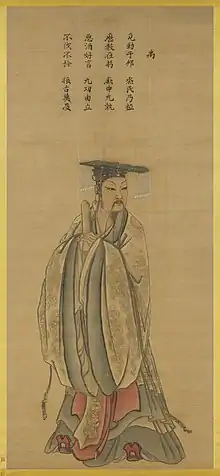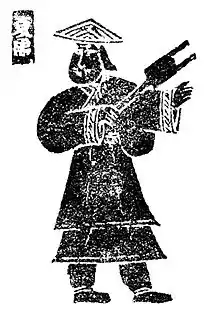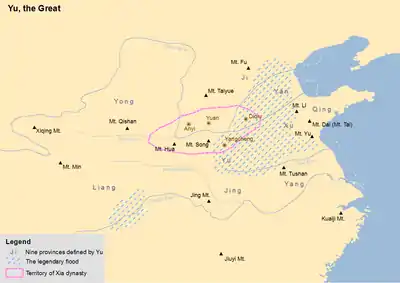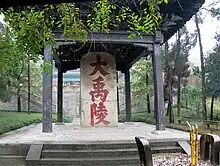Yu the Great
Yu the Great (大禹) was a legendary king in ancient China who was famed for "the first successful state efforts at flood control,"[1] his establishment of the Xia dynasty which inaugurated dynastic rule in China, and his upright moral character.[2][3] He figures prominently in the Chinese legend of "Great Yu Controls the Waters" (Chinese: 大禹治水; pinyin: Dà Yǔ Zhì Shuǐ).
| Yu 禹 | |||||||||||||||||||||||||||||
|---|---|---|---|---|---|---|---|---|---|---|---|---|---|---|---|---|---|---|---|---|---|---|---|---|---|---|---|---|---|
 Song Dynasty depiction of Yu | |||||||||||||||||||||||||||||
| King of the Xia dynasty | |||||||||||||||||||||||||||||
| Predecessor | Shun | ||||||||||||||||||||||||||||
| Successor | Qi | ||||||||||||||||||||||||||||
| Born | Shiquan County | ||||||||||||||||||||||||||||
| Died | Mount Kuaiji | ||||||||||||||||||||||||||||
| Spouse | Lady Tushan | ||||||||||||||||||||||||||||
| Issue | Qi of Xia | ||||||||||||||||||||||||||||
| Father | Gun | ||||||||||||||||||||||||||||
| Mother | Nüzhi (女志) or Nüxi (女嬉) | ||||||||||||||||||||||||||||
| Chinese name | |||||||||||||||||||||||||||||
| Chinese | 大禹 | ||||||||||||||||||||||||||||
| |||||||||||||||||||||||||||||
The dates which have been proposed for Yu's reign predate the oldest-known written records in China, the oracle bones of the late Shang dynasty, by nearly a millennium.[4] Yu's name was not inscribed on any artifacts which were produced during the proposed era in which he lived, nor was it inscribed on the later oracle bones; his name was first inscribed on vessels which date back to the Western Zhou period (c. 1045–771 BC).
The absence of near contemporary documentary evidence has caused significant doubt over Yu's historicity. Thus, proponents of his existence theorize that stories about his life and reign were orally transmitted in various areas of China until they were eventually recorded during the Zhou dynasty,[5] while opponents of it believe that the figure existed in legend in a different form—as a god or a mythical beast—during the Xia dynasty, and morphed into a human figure by the start of the Zhou dynasty. Many of the stories about Yu were collected in Sima Qian's famous Records of the Grand Historian. Yu and other "sage-kings" of Ancient China were lauded for their virtues and morals by Confucius and other Chinese teachers.[6]
Yu is one of the few Chinese monarchs who is posthumously honored with the epithet "the Great".
Name
Shuowen Jiezi (c. 121 CE) gives the earliest Chinese dictionary definition of yu 禹: "a 'bug, reptile', from the 'animal trampling tracks' radical, a 'pictograph' (蟲也从厹象形)".[7]
Historical linguist Axel Schuessler reconstructs 禹's Old Chinese pronunciation as *waʔ, and compares it to either Proto-Tibeto-Burman *was "bee; honey" or Proto-Waic *wak "insect" (further from Proto-Palaungic *ʋaːk).[8][9]
Ancestry and early life

Transmitted sources uniformly asserted that Yu was the son of Gun (鯀) (a kind of mythical fish),[10] though they differed on Gun's origins. According to Sima Qian's Records of the Grand Historian, Yu's father was Gun, grandfather was Zhuanxu, great-grandfather was Changyi, and great-great-grandfather was the Yellow Emperor, Changyi & Gun being mere officials, not emperors.[11][12][13][14] Book of Han, quoting Lord Yu Imperial Lineage, stated that Yu's father Gun was a five-generation-descendant of Zhuanxu.[15] The Classic of Mountains and Seas stated that Yu's father Gun (also known as "White Horse" 白馬, Báimǎ) was the son of Luómíng, who in turn was the son of the Yellow Emperor.[16]
Yu's father, Gun, was enfeoffed at Shiniu of Mount Wen (汶山), in modern-day Beichuan County, Sichuan Province; Yu was said to have been potentially born there,[17] though there are debates as to whether he was born in Shifang instead.[18] Yu's mother was of the Youxin clan (有莘氏) named either Nüzhi (女志) or Nüxi (女嬉). His surname was Si, later Xia after the state he was enfeoffed with, while his personal name was Wenming (文命), according to the Records of the Grand Historian.[19][20][21]
When Yu was a child, Emperor Yao enfeoffed Gun as lord of Chong, usually identified as the middle peak of Mount Song. Yu is thus believed to have grown up on the slopes of Mount Song, just south of the Yellow River.[22] Yu was described as a credulous, hard working, quick witted person with moral.[23] He later married a woman from Mount Tu (塗山) who is generally referred to as Tushanshi (塗山氏; 'Lady Tushan').[24] They had a son named Qi, a name literally meaning "revelation".[24]
The location of Mount Tu has always been disputed. The two most probable locations are Mount Tu in Anhui Province and the Tu Peak of the Southern Mountain in Chongqing Municipality.
A separate legend of Yu's birth is attested in an excavated manuscript provisionally provenanced to the Warring States period. In this legend, Yu's mother became pregnant after consuming the grains of a Job's tears plant, and gave birth to him through her back after a three-year gestation period.[25]: 132–133, 145
Great Yu controls the waters

During the reign of Emperor Yao, the Chinese heartland was frequently plagued by floods that prevented further economic and social development.[26] Yu's father, Gun, was tasked with devising a system to control the flooding. He spent more than nine years building a series of dikes and dams along the riverbanks, but all of this was ineffective, despite (or because of) the great number and size of these dikes and the use of a special self-expanding soil. As an adult, Yu continued his father's work and made a careful study of the river systems in an attempt to learn why his father's great efforts had failed.
Collaborating with Hou Ji, a semi-mythical agricultural master, Yu successfully devised a system of flood controls that were crucial in establishing the prosperity of the Chinese heartland. Instead of directly damming the rivers' flow, Yu made a system of irrigation canals which relieved floodwater into fields, as well as spending great effort dredging the riverbeds.[13] Yu is said to have eaten and slept with the common workers and spent most of his time personally assisting the work of dredging the silty beds of the rivers for the thirteen years the projects took to complete. The dredging and irrigation were successful, and allowed ancient Chinese culture to flourish along the Yellow River, Wei River, and other waterways of the Chinese heartland. The project earned Yu renown throughout Chinese history, and is referred to in Chinese history as "Great Yu Controls the Waters" (大禹治水; Dà Yǔ Zhì Shuǐ; Daai3 Jyu5 Zi6 Seoi2). In particular, Mount Longmen along the Yellow River had a very narrow channel which blocked water from flowing freely east toward the ocean. Yu is said to have brought a large number of workers to open up this channel, which has been known ever since as "Yu's Gateway" (Chinese: 禹門口).[13]
Apocryphal stories
In a mythical version of this story, presented in Wang Jia's 4th-century AD work Shi Yi Ji, Yu is assisted in his work by a yellow dragon (黃龍) and a black turtle (玄龜) (not necessarily related to the Black Tortoise (玄武) in Chinese mythology).[27] Another local myth says that Yu created the Sanmenxia in the Yellow River by cutting a mountain ridge with a divine battle-axe to control flooding.[28] This is perhaps a reference to a meteorite stone—something hard enough to etch away at the hard bedrock of Mount Longmen.
Traditional stories say that Yu sacrificed a great deal of his body to control the floods. For example, his hands were said to be thickly callused, and his feet were completely covered with calluses. In one common story, Yu had only been married four days when he was given the task of fighting the flood. He said goodbye to his wife, saying that he did not know when he would return. During the thirteen years of flooding, he passed by his own family's doorstep three times, but each time he did not return inside his own home. The first time he passed, he heard that his wife was in labor. The second time he passed by, his son could already call out to his father. His family urged him to return home, but he said it was impossible as the flood was still going on. The third time Yu was passing by, his son was more than ten years old. Each time, Yu refused to go in the door, saying that as the flood was rendering countless number of people homeless, he could not rest.[24][29]
Yu supposedly killed Gonggong's minister Xiangliu, a nine-headed snake monster.
Nine Provinces

Emperor Shun, who reigned after Yao, was so impressed by Yu's engineering work and diligence that he passed the throne to Yu instead of to his own son. Yu is said to have initially declined the throne, but was so popular with other local lords and chiefs that he agreed to become the new emperor, at age 53. He established a capital at Anyi (安邑), the ruins of which are in modern Xia County in southern Shanxi Province, and founded what would be called the Xia dynasty, traditionally considered China's first dynasty.[30]
Yu's flood control work is said to have made him intimately familiar with all regions of what was then Han Chinese territory. According to his Yu Gong treatise in the Book of Documents, Yu divided the Chinese "world" into nine zhou or provinces. These were Jizhou (冀州), Yanzhou (兗州), Qingzhou (靑州), Xuzhou (徐州), Yangzhou (揚州), Jingzhou (荊州), Yuzhou (豫州), Liangzhou (梁州) and Yongzhou (雍州).[31]
According to the Rites of Zhou there was no Xuzhou or Liangzhou, instead there were Youzhou (幽州) and Bingzhou (並州), but according to the Erya there was no Qingzhou or Liangzhou, instead there was Youzhou (幽州) and Yingzhou (營州).[31] Either way there were nine divisions. Once he had received bronze from these nine territories, he created ding vessels called the Nine Tripod Cauldrons.[32] Yu then established his capital at Yang City (陽城).[33] It is said in the Book of Documents that the Miao people rebelled under their leader, but he treated them harshly and so many abandoned him. He fought with Yu, who had the intention to kill him, but after defeating him spared him and reformed him for 3 years. He became wise and ruled well and the people returned.[34] The Bamboo Annals claim Yu killed one of the northern leaders, Fangfeng (防風) to reinforce his hold on the throne.[35][36]

Death

According to the Bamboo Annals, Yu ruled the Xia Dynasty for forty-five years and, according to Yue Jueshu (越絕書), he died from an illness.[36][37] It is said that he died at Mount Kuaiji, south of present-day Shaoxing, while on a hunting tour to the eastern frontier of his empire, and was buried there. The Yu mausoleum (大禹陵) known today was first built in the 6th century AD (Southern and Northern Dynasties period) in his honor.[38] It is located four kilometers southeast of Shaoxing city.[38] Most of the structure was rebuilt many times in later periods. The three main parts of the mausoleum are the Yu tomb (禹陵), temple (禹廟) and memorial (禹祠).[39] Sima Qian once "went to Kuaiji and explored the cave of Yu". The tomb faces east and west and has a grate gate, a canal and a pavilion for the Great Yu Tomb.[40] In many statues he is seen carrying an ancient hoe (耒耜). A number of emperors in imperial times traveled there to perform ceremonies in his honor, notably Qin Shi Huang.[37]
Historicity
Because no contemporary documentary evidence about Yu survives, only a body of accumulated myth and legend, there is significant doubt as to the historicity of this figure. No inscriptions on artifacts dated to the supposed era of Yu, or the later oracle bones, contain any mention of Yu. The first archeological evidence of Yu comes from vessels made about a thousand years after his supposed death, during the Western Zhou dynasty.[41]: 77
The Doubting Antiquity School of early-20th-century historians, for example, theorized that Yu was not a person in the earliest legends, but rather a god or mythical beast who was connected with water and possibly with the mythical legend Dragon Kings and their control over water. According to this theory, Yu (as god or beast) was represented on ceremonial bronzes by the early Xia people, and by the start of the Zhou Dynasty, the legendary figure had morphed into the first man, who could control water, and it was only during the Zhou Dynasty that the legendary figures that now precede Yu were added to the orthodox legendary lineage. According to the Chinese legend Yu the Great was a man-god.
Archaeological evidence of a large outburst flood at Jishi Gorge on the Yellow River has been dated to about 1920 B.C. This coincides with new cultures all along the Yellow River. The water control problems after the initial flooding could plausibly have lasted for some twenty years. Wu and coauthors suggest that this supports the idea that the stories of Yu the Great may have originated from a historical person.[42]
Legacy

Yu was long regarded as an ideal ruler and kind of philosopher king by the ancient Chinese. Beichuan, Wenchuan, and Dujiangyan in Sichuan have all made claims to be his birthplace.[43]
Owing to his involvement in China's mythical Great Flood, Yu also came to be regarded as a water deity in Taoism and the Chinese folk religions. He is the head of the "Five Kings of the Water Immortals" honored in shrines in Matsu temples as protectors of ships in transit.[44]
His personal name eventually became a Chinese surname. The name was a simplification of minor Yu Kingdom, in modern-day Shandong. After its conquest by the state of Lu, its subjects adopted Yu as a surname.[45]
See also
- Family tree of ancient Chinese emperors
- Flood myth
- Great Flood (China)
- Natural disasters in China
- Yubu
- Rishu
- Xi Zhong, the minister claimed to have served for the emperor and invented the chariot according to some Chinese sources
References
- Ivanhoe, Philip J.; Van Norden, Bryan W. (2005). Readings in Classical Chinese Philosophy (2nd ed.). Indianapolis: Hackett Publishing Company. p. 383. ISBN 0-87220-781-1. OCLC 60826646.
- Mungello, David E. (2009). The Great Encounter of China and the West, 1500–1800 (3 ed.). Rowman & Littlefield. p. 97. ISBN 9780742557987. Archived from the original on 2023-04-25. Retrieved 2020-12-17.
- Dai & Gong (2003), p. 40
- Underhill, Anne P., ed. (2013). A Companion to Chinese Archaeology. Wiley-Blackwell. p. 317. ISBN 978-1-4443-3529-3. Archived from the original on 2023-04-25. Retrieved 2016-10-20.
- Allan, Sarah (1991). The Shape of the Turtle: Myth, Art, and Cosmos in Early China. State University of New York Press. p. 21. ISBN 978-0-7914-9449-3.
- Dai & Gong (2003), p. 36
- Xu Shen. "15 - Radical 厹". Shuowen Jiezi. Archived from the original on 2023-04-25. Retrieved 2022-02-04.
- Schuessler, Axel (2007). ABC Etymological Dictionary of Old Chinese. University of Hawai'i Press. p. 588
- Sidwell, Paul (2015). The Palaungic Languages: Classification, Reconstruction and Comparative Lexicon. München: Lincom Europa. p. 103
- Kangxi Dictionary, vol. 15 "魚 radical 7" Archived 2021-12-06 at the Wayback Machine quote: "鯀:《唐韻》《集韻》《正韻》𠀤古本切,音袞。《說文》魚也。《玉篇》大魚也。又《書·堯典》於,鯀哉。《傳》鯀,崇伯之名。《釋文》禹父也。《廣韻》亦作鮌。"
- Shiji, Annals of Xia "Annals of Xia" Archived 2021-07-09 at the Wayback Machine quote: "禹之父曰鯀,鯀之父曰帝顓頊,顓頊之父曰昌意,昌意之父曰黃帝。禹者,黃帝之玄孫而帝顓頊之孫也。禹之曾大父昌意及父鯀皆不得在帝位,為人臣。"
- Book of Generations' Origins (世本) "Xia" Archived 2020-11-11 at the Wayback Machine quote: "顓頊生鯀。…… 鯀為顓頊子。…… 顓頊生𩩌,𩩌生高密,是為禹也。
- Dai & Gong (2003), p. 38
- Zynews.com. "Zynews.com Archived 2011-07-18 at the Wayback Machine." Xia dynasty brief history. Retrieved on 2010-09-18.
- Ban Gu; Ban Zhao; Ban Biao. "on Regulations and Calendars B"". Hanshu. Archived from the original on 2021-07-09. Retrieved 2021-07-09. text: "伯禹帝系曰,顓頊五世而生鯀,鯀生禹"
- Shanhaijing vol. 18 Archived 2021-07-09 at the Wayback Machine "黄帝生駱明,駱明生白馬,白馬是為鯀。"
- "Jiangsu.gov.cn Archived 2011-07-18 at the Wayback Machine." 四川省汶川縣情及人文地理. (Chinese) Retrieved on 2010-09-18.
- Scta.gov.cn. "Scta.gov.cn Archived 2011-07-07 at the Wayback Machine." (Chinese) Retrieved on 2010-09-18.
- Shiji, Annals of Xis"夏禹,名曰文命。" Archived 2021-07-09 at the Wayback Machine
- Sima Qian's discussion Archived 2021-12-27 at the Wayback Machine on "Annals of Xia" in Records of the Grand Historian: "禹爲姒姓,其後分封,用國爲姓,故有夏后氏、有扈氏、有男氏、斟尋氏、彤城氏、襃氏、費氏、杞氏、繒氏、辛氏、冥氏、斟戈氏/斟灌氏" translation: "Yu was surnamed Si, he later was enfeoffed [and] used the nation['s appellation] as surname. Thence [we] have the surnames: Xiahou, Youhu, Younan, Zhenxun, Tongcheng, Bao, Fei, Qi, Zeng, Xin, Ming, Zhenge/Zhenguan"
- Shiji "Annals of the Five Emperors" Archived 2022-05-10 at the Wayback Machine "帝禹為夏后而別氏,姓姒氏。"
- Hubeiwater.gov.cn. Hubeiwater.gov.cn 大禹三过家门而不入与洪湖抗洪十字歌的精神浅谈. Archived 2011-07-07 at the Wayback Machine (Chinese). Retrieved on 2010-09-18.
- Shiji 禹爲人敏給克勤;其惪不違,其仁可親,其言可信;聲爲律,身爲度,稱以出
- Wang (2006), p. 18
- Allan, Sarah (2009). "Not the Lun Yu: The Chu Script Bamboo Slip Manuscript, Zigao, and the Nature of Early Confucianism". Bulletin of the School of Oriental and African Studies, University of London. Cambridge University Press. 72 (1): 115–151. JSTOR 40378848.
- Lu Xing. Rhetoric in ancient China, fifth to third century, B.C.E.: a comparison with classical Greek rhetoric. (1998). Univ of South Carolina Press publishing. ISBN 1-57003-216-5, ISBN 978-1-57003-216-5. p 46–47.
- Lewis, Mark Edward (2006), The flood myths of early China, SUNY series in Chinese philosophy and culture, SUNY Press, pp. 104–105, 191–192, ISBN 0-7914-6663-9, archived from the original on 2023-04-25, retrieved 2020-09-17 (especially, notes 90 and 97). The relevant text is in Shi Yi Ji, Chapter 2: "黃龍曳尾於前,玄龜負青泥於後", etc.
- Destguides.com. "Destguides.com". Sanmenxia. Retrieved on 2010-09-26.
- Wang (2006), p. 19
- Wang (2006), p. 21
- Ng Saam-sing 吾三省. (2008). Zong-guok Man-faa Bui-ging Bat-cin Ci 中國文化背景八千詞. Hong Kong: Seong Mou Jan Syu Gwun 商務印書館(香港). ISBN 962-07-1846-1, ISBN 978-962-07-1846-5. p 37.
- Bjaaland Welch, Patricia. [2008] (2008). Chinese art: a guide to motifs and visual imagery. Tuttle Publishing. ISBN 0-8048-3864-X, 9780804838641. p 262.
- 李玉潔. [2003] (2003). 中國早期國家性質. 知書房出版集團. ISBN 986-7938-17-8, ISBN 978-986-7938-17-6.
- The Most Venerable Book (Shang Shu). Translated by Martin Palmer. Penguin Books, Limited. 2014. ISBN 978-0-14-119746-3. Archived from the original on 2023-04-25. Retrieved 2022-12-30.
- 王仲孚. [1996] (1996). 中國上古史專題研究. 五南圖書出版股份有限公司. ISBN 957-11-1290-9, ISBN 978-957-11-1290-9. p 392.
- Bamboo Annals Xia chapter
- 大禹祭典. Chinaculture.org. Archived from the original on 2010-09-11. Retrieved 2010-09-26.
- China.org.cn. "China.org.cn Archived 2012-07-17 at the Wayback Machine." Yu Mausoleum. Retrieved on 2010-09-26.
- lvyou.eco.gov.cn. "lvyou.eco.gov.cn Archived 2011-07-07 at the Wayback Machine." 治水英雄大禹的葬地:大禹陵. Retrieved on 2010-09-26.
- "Yu mausoleum". Archived from the original on 2022-12-06. Retrieved 2022-12-06.
- Cook, Constance A. (2013). "Sage King Yu 禹 and the Bin Gong xu 豳公盪". Early China. Cambridge University Press. 35/36: 69–103. JSTOR 24392401.
- Qinglong Wu; et al. (2016). "Outburst flood at 1920 BCE supports historicity of China's Great Flood and the Xia dynasty". Science. 353 (6299): 579–582. Bibcode:2016Sci...353..579W. doi:10.1126/science.aaf0842. PMID 27493183. S2CID 206646492.
- Sichuan.scol.com.cn. "Scol.com.cn Archived 2011-07-07 at the Wayback Machine." 发现西羌古道有关遗迹大禹故乡迷雾更浓 . Retrieved on 2010-09-26.
- "Shuexian Deities", Official site, Tainan: Grand Matsu Temple, 2007, archived from the original on 2020-09-20, retrieved 2016-12-05.
- The Oxford Dictionary of Family Names in Britain and Ireland
Sources
- 戴逸 (Dai Yi); 龔書鐸 (Gōng Shūduó) (2003). 中國通史. 史前 夏 商 西周 [History of China. Illustrated student edition]. Intelligence Press. ISBN 962-8792-80-6.
- Sima Qian; Sima Tan. "34.4: 燕召公世家". Records of the Grand Historian 史記. Archived from the original on 2023-04-18. Retrieved 2023-04-25.
- 王恆偉 (Wang Hengwei) (2006). "Yuan Gu Zhi Chunqiu" 遠古至春秋 [Ancient times to the Spring and Autumn period]. Zhongguo Lishi Jiangtang 中國歷史講堂 [Chinese history lectures]. Zhonghua Book Company (中華書局). ISBN 962-8885-24-3.